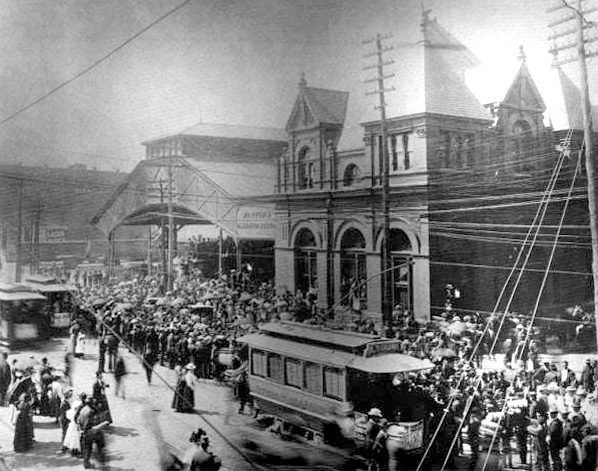1st Alabama Volunteer Infantry

The 1st Alabama Volunteer Infantry was a military regiment organized in 1898 for service to the United States in the Spanish-American War. The unit remained in Florida through the end of the war and did not see action.
The Birmingham Battalion gathered at Union Station on May 1 and traveled via the Louisville & Nashville Railroad to Mobile, where the regiment was formally organized into companies. The collected force, under command of Colonel E. L. Higdon, numbered 48 officers and 941 enlisted. It was initially assigned to the Third Brigade of the First Division of the Fourth Army Corps, but transferred to the First Brigade, First Division of the Seventh Army Corps under Major General Fitzhugh Lee on June 25, just as they left Mobile for Miami, Florida. Accompanying the unit as principal musicians were Oscar Wolff of New Orleans, Louisiana; Forest Chance of Birmingham; and Emmett Craddock of Columbus, Mississippi.
On August 12 the regiment left Miami for Camp Cuba Libre near Jacksonville, Florida. Spain and the United States agreed to an armistice that same day. The 1st Alabama remained in camp until September 13. The units returned to Alabama beginning on September 13. The Birmingham units arrived on the L & N via Montgomery on September 17. Mayor Frank Evans chaired a reception committee that organized their public welcome. Among the crowd were Civil War veterans representing Camp Hardee and Camp Davis of the United Confederate Veterans and Camp Thomas of the Grand Army of the Republic. The ladies on the committee organized a pot-luck of home cooked foods to accompany the returning soldiers to their encampment. Higdon was presented with a silver berry bowl with gold inlay by his grateful enlisted men.
After arriving at Union Station each battalion paraded around Block 99. The companies then boarded East Lake Railroad cars to East Lake to retrieve their personal belongings from freight cars taken there and make camp before being discharged. A group of physicians assembled to take charge of the sick and wounded. At East Lake the soldiers gratefully received not only the car-load of food, but also their pay. By order of Secretary of War Russell Alger the volunteers were given the option of purchasing their government-issued Springfield-made Krag–Jørgensen .30 Army rifle, knapsack, canteen, cartridge belt and other equipment in exchange for 1 months's pay.
During their stay in East Lake, many took advantage of the opportunity to become drunk, and numerous fights and "rampages" were reported, including the fatal shooting of John Slate by fellow Private David McClung on September 19. Colonel Higdon ordered a 30-day furlough in order to disperse the group, with orders to return on October 20. 200-300 men remained in camp to secure property left there.
The regiment, then consisting of 1,089 enlisted and 49 officers, was mustered out of service on October 31. It had lost 1 officer and 15 men to disease while 31 others were discharged for disability and 32 deserted. The United States and Spain formally signed the Treaty of Paris on December 10.
Companies
- 1st Alabama Volunteer Infantry, commanded by Colonel E. L. Higdon
- Birmingham Battalion, commanded by Major Thomas O. Smith
- Company A: Woodlawn Light Infantry , commanded by Captain William Parks
- Company G: Jefferson Volunteers, commanded by Captain Hugh Kennedy
- Company K: Birmingham Rifles, commanded by Captain Charles Ledbetter
- Company L: Huey Guards (East Lake), commanded by Captain George Hart, succeeded at his death by Captain Newman Lacy
- Second Battalion, commanded by Major Daniel McLeod
- Company C: Etowah Rifles, commanded by Captain Nelson Canning
- Company E: Joe Johnston Rifles (Decatur), commanded by Captain William E. Wallace
- Company H: Bessemer Rifles, commanded by Captain Thomas Huey
- Company I: Oxford Guards, commanded by Captain Arthur Harrison
- Third Battalion, commanded by Major Osceola Kyle
- Company B: Wheeler Rifles (Florence), commanded by Captain William M. Martin
- Company D: Anniston Rifles, commanded by Captain George Tumlin
- Company F: Huntsville Rifles, commanded by Captain Humes Laughlin
- Company M: Clark Rifles (Pratt City and Talladega), commanded by Captain Romain Boyd
- Birmingham Battalion, commanded by Major Thomas O. Smith
References
- "Gray Veterans and Pretty Girls" (September 17, 1898) The Birmingham Age-Herald, p. 5
- "Fatal Affray in the First Alabama Yesterday Afternoon" (September 20, 1898) The Birmingham News, p. 5
- "Alabama Volunteers in the Spanish American War" (1899) Alabama Adjutant Generals Office
- "Statistical Exhibit of Strength of Volunteer Forces Called into Service During the War with Spain; with Losses from All Causes." (1899) Government Printing Office
- Wright, Marcus J. (1900) Wright's Official History of the Spanish American War. War Records Office, p. 237